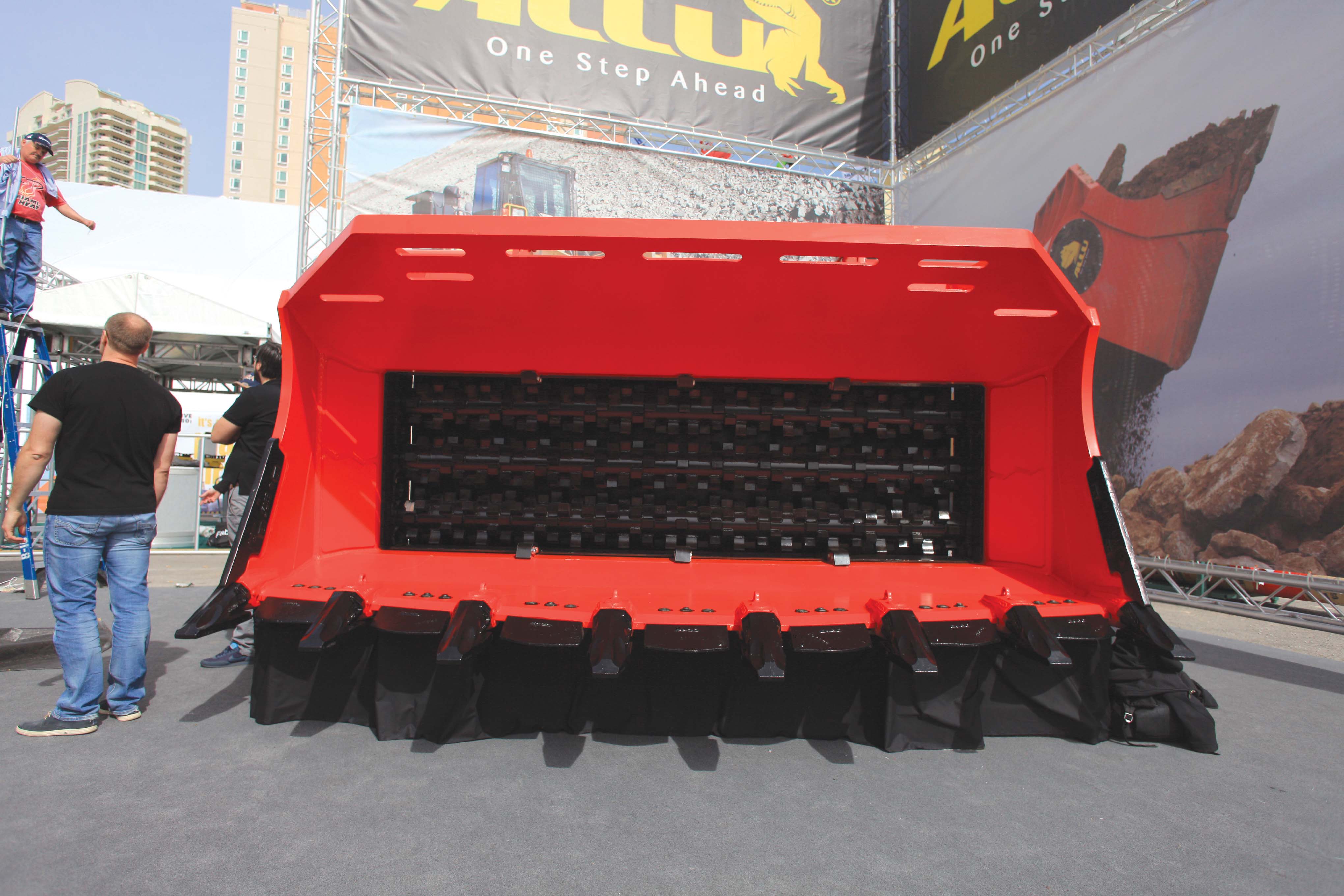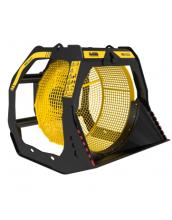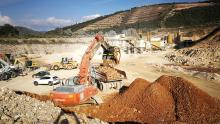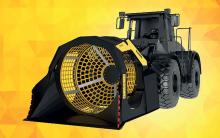
Investment and running costs, reliable equipment and efficient material flow are key issues in any quarrying and mining operation.
And
This is done by converting existing loaders and excavators into primary and secondary crushing and screening machinery by using Allu screener crusher technology.
Indeed, crushing and screening buckets are said to be among the latest innovations in hydraulic attachments with the latest developments building on those of the late 1990s when the first crusher buckets for use in demolition and recycling applications were launched.
Allu, one of the first to develop the technology for crushing light demolition waste over 20 years ago, is now one of a number of manufacturers with global sales. The bucket crusher, which was developed from traditional jaw crusher technology, uses hydraulic power from the loader or excavator to which it is attached, making it easy to gather rock, crush and load into trucks or use in situ.
Among applications for bucket crushers are demolition, quarrying and mining, rock breaking or crushing of quarry material, building construction, earthmoving and excavation.
According to Austrian manufacturer Hartl, another major player in the sector, demand for highly mobile crushing is growing strong and fast, and last year the market for such bucket crushers increased to more than 2.500 machines.
“Investment costs are lower compared to big stationary processing stations. Transportation from one site to another is easy and fast, no expensive special arrangements are needed. There is also no need for on-site electrics,”
says Allu.
“Whether a small mine, a contractor working in several mining operations, or a large opencast mine, Allu´s one-step crushing and loading method helps to reduce costs and boosts efficiency. End users, such as power plants, storage areas, harbours and classification sites can also benefit from the method.”
Allu, which was among a number of companies unveiling new products recently, says crushing and loading the raw material is completed in one step, thus reducing the need of buffer storage areas and material transport.
It took the wraps off its new M Series attachment for the mining and quarrying sector, a series of bucket crushers with the attachment available in three models for excavators from 50tonnes-160tonnes and three models for wheeled loaders from 30tonnes-90tonnes.
“Allu M Series mobile solution for soft rock mining, or as most of us call it the Monster, is designed for mining, more specifically for crushing of soft rock and minerals,” says the company.
“These new units are on their way to change the rock and mineral mining processes for good.”
Allu says it has taken the attachment one step further and is “introducing a new way of working for mining sector as well.”
“By cutting unnecessary steps from the material processing, from a seven-step process to two-step process, the mining operation can be executed efficiently and at the same time make substantial savings in primary mining processes.”
Customer demand has seen the company develop a cartridge drum replacement system for its DL range of screening and aerating buckets, allowing customers to change processing drums with minimal fuss. Patented rear- mounted drums mean that the complete drum and bearing assembly can be removed and replaced, allowing customers to adapt their Allu bucket to suit different conditions and jobs.
The Allu DL series includes a range of 15mm to 50mm screening and aerating buckets to fit 2-12tonne excavators, tele-handlers and skid-steers. Applications include fine screening, aeration and homogenising consolidated materials such as soil or clay for backfill.
Hartl Crusher unveiled its new venture of highly mobile and economic crushing solutions as well as introducing its entire product range of eight different models of bucket crushers and screeners at
The company says it combines more than 85 years industry experience and more than 40 years innovation in the field of rock crushers and screeners produced by the Hartl family.
The company says that by applying technology to an extremely robust structure, it has integrated a jaw crusher into the form of an excavator bucket offering high performance in the crushing and separation of natural stone and recycling material on site.
“Thanks to the Hartl Quattro movement, these crushers deliver a very high average performance and throughput and an exceptional quality cubical end product with a minimal percentage of oversized material,” says Hartl.
“Low running costs and environmentally friendliness are key words, and formed an integral part of the design process. The Hartl bucket crusher was honoured in 2013 with the Red Dot Design Award.”
With the new generation of bucket crushers and screeners Hartl says it is offering operators in the material processing industries “a solution for a flexible, highly mobile and economical crushing and separating.”
Hartl’s support and after-sales service is through a global dealer network in 68 countries and an “industry first” Web shop system to order parts, including order tracking and visual instruction for mounting and servicing of Hartl products.
The
“There are numerous applications possible: from demolition to construction works in general; the remediation of industrial and urban waste; to process materials from quarries; from the earthmoving sector to road works; from quarrying to mining; fromenvironmental remediation to crushing rocks,” says the Dutch company.
As with other manufacturers, it says the benefits of its HCB-Series crushing buckets include crushing all types of demolition waste; crushing directly on the jobsite; reducing the use of mechanical means; lifting the problem of processing on the landfill of demolition materials; and reducing transportation costs of granulate from and to the jobsite. There are three models available for machines from 12-45tonnes, and the crushing bucket is connected to the hydraulic hammer lines of the excavator with the size of the outgoing material being adjustable.
The Hydraram HSB-Series screening bucket range, said to be ideal for the sorting of natural material, offers 11 models for machines from 3-40tonnesand these can be used for many applications: primary sorting of waste and demolition materials, screening of backfill for excavations and materials for the rehabilitation of rocky terrain; sorting of gravel in streams and cleaning of beaches.
“These are indispensable in all the circumstances where finer material must be obtained or where materials of different thicknesses have to be sorted,” says Hydraram.
Screening is carried out directly on the job site where the mesh size of the screen is easily adjusted by changing screen panels. As with the crushing buckets, the screening buckets are connected to the excavator’s hydraulic hammer lines.
At Conexpo, Finnish company Remu showcased reinforced screening buckets and screener-crushers for rough conditions, saying that its US customers’ wishes have been fulfilled with a series of screening bucket improvements.
For example, the models include wear-resistant steel rotors and high-strength wear-resistant Raex steel by Ruukki, which is said
to extend the lifespan of machinery while the wear in structural components is decreased and costs are saved.
The buckets also have bolt attached comb counter blades and cleaning scrapers and bolted side doors and plugs for greasing in the EE series.
Despite the downturn in its home country of Italy, attachment manufacturer
“All our growth came from outside the domestic market and mainly outside Europe. Sales in Central and South America and Asia led to this increase,” says Federico Tamburri, assistant general manager at Simex.
Simex sells a limited range of attachments in the US and Canada as it has contracts with major OEMs in the market which prevent it from selling its highest value attachments there. But at Conexpo its stand was attracting visitors from outside North America too.
Crusher buckets are the most important product in the North American market, says Tamburri. The US is the only market to which Simex sells its biggest crusher bucket, the CBE50, which can be fitted onto excavators up to 60tonnes.
The company also highlighted its new VSE40, a screening bucket with a patented mechanism that allows the operator to change the size of the screened material from the cab at the touch of a button. Standard products take several hours to change settings.
The prototype was unveiled at bauma 2013.
“We are delivering the first units to Italian customers because we want to keep the youngest units close to home,” says Tamburri, who added that he had a number of orders waiting on his desk for the attachment to go through this final test phase.
At the same time, Simex is working on smaller versions of the VSE40.
“Within a year we could be presenting at least three models of the screener.”









